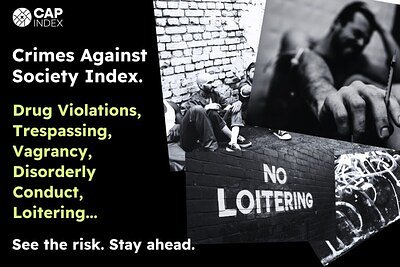
Beyond Crime Stats: New Index Maps ‘Social Risk’ for Businesses & Communities
A new risk assessment tool goes beyond traditional crime data, quantifying ‘social disorder’ to help businesses and communities proactively address safety concerns. But is it a predictive tool, or does it risk reinforcing biases?
Beyond Crime Stats: New Index Maps ‘Social Risk’ for Businesses & Communities
By George Millen
Cleveland, OH – For decades, businesses assessing risk have relied heavily on traditional crime statistics. But a growing recognition that where crime happens is often tied to what is happening – the subtle indicators of social disorder – is driving a shift in risk assessment methodologies. CAP Index, a provider of location-based risk intelligence, recently launched its “Crimes Against Society” (CAS) index, aiming to quantify these often-overlooked factors and provide a more holistic view of community safety.
While traditional crime data focuses on offenses against people and property, the CAS index looks at behaviors like loitering, trespassing, and minor drug violations – actions that, while not always criminal on their own, can signal a decline in community stability and potentially escalate into more serious offenses. CAP Index claims this provides a proactive risk assessment beyond simply reacting to incidents.
“We’re moving beyond simply counting burglaries and assaults,” explains a spokesperson for CAP Index. “The CAS index aims to identify areas where social fabric is fraying, allowing businesses and communities to address these issues before they escalate.”
Beyond Traditional Metrics
The CAS index isn't operating in a vacuum. Experts have long recognized the connection between social disorder and crime. The “Broken Windows Theory,” though controversial, posits that visible signs of crime and civil disorder create an environment conducive to more serious offenses. However, simply quantifying these issues presents a significant challenge.
“The idea of mapping ‘social risk’ is conceptually sound,” says a security consultant specializing in retail loss prevention, speaking anonymously. “But the devil is in the details. How do you accurately capture these nuanced behaviors, and how do you ensure the data isn’t skewed by policing practices or biases?”
CAP Index addresses this by assessing risk at the granular level of census block groups, combining local law enforcement reports with demographic and socio-economic data. The company claims this hyperlocal approach provides a more accurate and nuanced picture of community safety. However, the reliance on law enforcement data remains a critical point of concern.
The Bias Question
Several sources interviewed for this article raised concerns about the potential for bias in the CAS index. Over-policing in certain neighborhoods, for example, could lead to inflated CAS scores, falsely indicating higher risk levels. Conversely, under-resourced areas might have lower reported rates of social disorder, masking potential dangers.
“If you’re solely relying on police reports, you’re likely capturing the response to social disorder, not the disorder itself,” explains a community activist working in urban development, requesting anonymity. “Communities of color are often disproportionately targeted by law enforcement, so you risk perpetuating existing inequalities.”
CAP Index acknowledges these concerns and emphasizes the importance of contextualizing the data. The company claims its models incorporate demographic and socio-economic factors to mitigate the impact of bias. However, critics argue that simply adjusting the data isn’t enough.
“You need to consider the systemic factors that contribute to social disorder in the first place,” says a security consultant. “Poverty, lack of opportunity, and historical inequalities all play a role. A risk assessment tool can’t solve those problems.”
Moving Beyond Reactive Security
Despite the potential challenges, the CAS index represents a broader shift toward more proactive and data-driven security measures. Retailers, banks, and real estate developers are increasingly using location-based risk assessments to inform decisions about store placement, branch security, and investment strategies.
“We’re seeing a growing demand for tools that can help businesses understand the risks they face beyond just traditional crime statistics,” says a representative from a retail loss prevention firm. “The CAS index provides a more holistic view of community safety, allowing businesses to make informed decisions about where to invest and how to protect their assets.”
However, experts caution against relying solely on risk assessment tools. Community engagement, social responsibility, and addressing the root causes of social disorder are essential components of a comprehensive safety strategy.
“A risk assessment tool is just that – a tool,” says a community activist. “It can provide valuable information, but it shouldn’t replace genuine community engagement and a commitment to social justice.”
The Future of Risk Assessment
The CAS index is a step toward a more nuanced and proactive approach to risk assessment. However, its success will depend on addressing the potential biases in the data, engaging with communities, and recognizing that security is not just about protecting assets, but also about building thriving and equitable communities. As technology continues to evolve, the future of risk assessment will likely involve integrating a wider range of data sources, leveraging artificial intelligence, and incorporating more sophisticated analytical techniques. But the most important element will remain the same: a commitment to understanding the complex social and economic factors that shape community safety.
“We are always looking for ways to improve our models and incorporate more comprehensive data sources,” says a spokesperson for CAP Index. “The goal is to provide businesses and communities with the information they need to make informed decisions and create safer, more vibrant communities for everyone.”
Research Sources:
- CAP Index Website: https://capindex.com/
- Retail Loss Prevention Industry Reports (Various)
- Banking and Financial Services Security Reports (Various)
- FBI Uniform Crime Reporting (UCR) Data
- Demographic Data from US Census Bureau
- Interviews with security consultants, community activists, and retail loss prevention professionals (anonymous).
